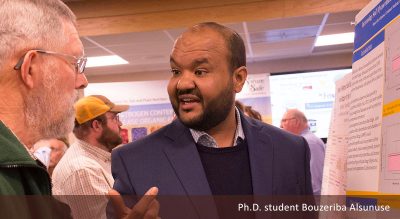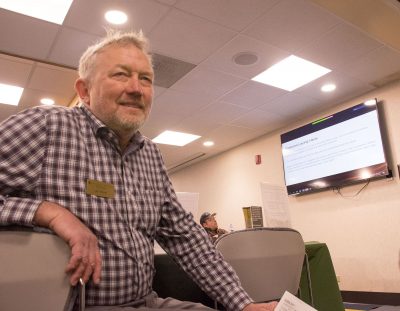There was no guarantee in 1980 that farmer-by-day and songwriter-when-time-allowed Mark Jones wouldn’t be singing the bankrupt blues in just a few years.
He had taken over the family’s four properties in Nebraska when his father died. They were swirling in debt.
Jones, who was attending his sixth organic growers conference in Cheyenne last month, said he clamped down on every expense in an attempt to stay afloat.
He said switching to organic agriculture 35 years ago saved his farms.
“My wife, Marcy, is the one who got us lined up and enthusiastic about being organic. We could not have done it with Marcy,” he said.

Jones, who farms near Oshkosh, Nebr., is an enthusiastic organic production supporter and said he attends such conferences to lend support for others.
“Most of the (organic producers) are like me,” he said. “I have a long spiel for everything. We’re a little bit isolated from each other, and most of us are really happy to talk to someone getting started.”
More than 100 attended this year’s conference, said organizer Jay Norton, a soils science professor at the University of Wyoming. The event has probably outgrown the rooms in Laramie County Community College’s Center for Conferences and Institutes.
“We are growing and will probably move to the Pathfinder Building (at LCCC),” said Norton, who added the dryland production systems drew a lot of interest this year. There was standing room only for that session.
“Part of (the interest) I’ve been told by producers is the low prices for wheat and the high premium for dryland grains, especially wheat,” said Norton.
Organic producers can receive two to three times the price compared to conventional wheat.
Wyoming has about 120,000 certified organic acres. About 77,000 acres are cropland and 46,000 pastureland/rangeland, according to the USDA. Winter wheat for grain or seed and dry hay are the top commodities sold. Crop sales totaled about $9.2 million, and hay sales were valued at $2.1 million.
Switching to organic wheat isn’t a big step for many producers, Norton said. Southeast Wyoming wheat producers don’t use a lot of inputs like fertilizers due to sparse moisture. Norton said hail and drought usually have a bigger impact on yields than inputs.
“If they own or lease land in the Conservation Reserve Program and take that out, it’s ready to go. There is no transition,” Norton said.
Farmers enrolled in CRP remove environmentally sensitive land from production and plant species that improve the health and quality of soil and in exchange receive a yearly rental payment. CRP contracts lengths are 10 to 15 years.
This year’s organic conference had 22 speakers ranging from small growers to large commercial operators. Sessions were offered for dryland systems, specialty crops and forage and livestock.
Nate Powell-Palm received his organic certification from the Montana Department of Agriculture while most his age (high school junior) were worrying about being accepted by their friends. He was Montana’s youngest certified organic farmer for several years and now raises cattle and grain around Bozeman and the northern Wyoming area. He’s on the governing council of the Organic Farmers Association.
He thinks Wyoming is prime for an organic grower organization.

A Montana organic growers group formed in 2002 and meetings had low attendance its first few years. More than 350 attended last December’s meeting.
“Whenever you have a chance for peer-to-peer sharing, that’s a great thing,” Powell-Palm said. “I think this (conference) is a great start. What I would say is that a way to start off would be for more Wyoming folks attending the Montana conference in Bozeman this December.”
Powell-Palm has served as vice president and president of the Montana Organic Producers Coop, a 22-member certified organic beef marketing cooperative. He said despite his youngish looks – and a $3,000 combine – he has never been confronted by conventional growers about his organic farming.
“I think because I’m not approaching this as divisive, that I’m better,” he said. “I want to be a farmer, and this is the way I can do it. Economically, it’s the way farming can become sustainable and not have whiplashes in the market that gives such heartburn in the profession.”
He harvests his 200 acres of wheat with his combine and only grows what will be bought, farms small fields, does not own land and carries no debt.
“I always have a crop sold,” Powell-Palm said.
Growing only crops that will be bought is something organic growers have done well, he said.
“We are getting more and more buyers and spot buyers,” he said. “I know there is a market out there for all organic – what do you want me to grow? Can I grow it? Then that’s what I’m going to grow.”
He vows he will never get stuck into a position, for example, of only growing spring wheat, and there’s too much inventory and then producers have to hustle to get rid of it.
“I want to grow a crop someone is willing to pay a good price for and then get rid of it,” he said.

Jones said his Organic Crop Improvement Association grower number obtained in 1985 is 707, with more than 50,000 members now. The Jones family started with organic amaranth and grow wheat, millet, flax and also some blue corn and beans.
He has advice for producers considering going organic.
“Make sure your family is involved in this, especially your wife,” Jones said. “That is such a huge asset to have both partners involved in it.”
Ensure the entire family is on board and aware of what going organic will take, he added.
“You have to look at the trends and see the most profitable way to keep your business afloat,” Jones said. “I think the first thing you do is see where your heart is and then see where your finances are and see what kind of program fits your particular business.”





